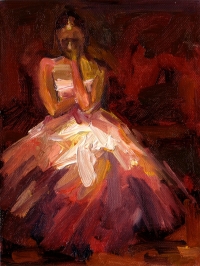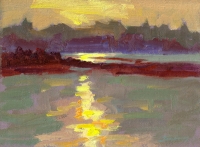
On my last visit home, my mother presented me with a scrap book of items she kept of mine while growing up, including photos, old artwork and perhaps most telling–report cards! I remember school a bit, but reading these teacher/parent notes about ‘young Edward’ brought me back to that time.
I remember being bored in school and my teacher’s notes from kinderkarten onward confirm that. I guess I didn’t get serious about school until college, when I had more of a “choice” about what to study. The exception to the rigors of public school was the eary music education I got. This was a luxury, as from 13 on my mother raised 4 children alone. There were definite hardships, and so getting music lessons meant a lot.
 I played multiple instruments, but excelled on the Trombone, playing jazz, classical, you name it. My private teacher–Mr. VanFleet–was (is? I don’t know, we’ve lost touch) an incredible teacher. I’m sure he wouldn’t mind me calling him a “hard ass”. A Marine drill-instructor to the core (have no idea if he served, but he’d be a natural), he SCARED you into practicing. If you showed up to your private lesson not having learned your assignment–forget it. Run.
I played multiple instruments, but excelled on the Trombone, playing jazz, classical, you name it. My private teacher–Mr. VanFleet–was (is? I don’t know, we’ve lost touch) an incredible teacher. I’m sure he wouldn’t mind me calling him a “hard ass”. A Marine drill-instructor to the core (have no idea if he served, but he’d be a natural), he SCARED you into practicing. If you showed up to your private lesson not having learned your assignment–forget it. Run.
One of his techqniques for teaching musing–shared by many, this is in no way unque–was “sight reading“, or playing a piece of music for the first time, “on sight” with no preparation. It was a great way to train the musician to react quickly AND think ahead, or I should say, read ahead. You’re playing a passage and always looking a few bars ahead to figure out, “where’s this going?”. He’ll hand you a piece that could be just as easily a sonota as jazz. You’re not expected to play perfectly since the point is the process, not the result.
So what’s this got to do with art and learning? Applying musical “site reading” to art (I call it “Sight Painting”) is a great learning tool. Here’s how it works: I fill my camera with random images from my huge digital library. In my studio, I attatch the camera to a TV to project the images. I then pick a random number and scroll through the camera’s images until I hit it. I set a timer, usually 15 minutes. Then I paint the image quickly. Sometimes I see great results, often not, but the painting’s not the point–the process is. You learn not to get fussy with your brush (I always use a brush larger than I think I need for these exercises, and use one brush throughout). You learn to mix color quickly and create new threads of color from old colors on your palette (which great harmonizes the painting). You think big shapes and work smaller–if you have time! Lastly, you often get an image with incredible life and passion.
Painting”) is a great learning tool. Here’s how it works: I fill my camera with random images from my huge digital library. In my studio, I attatch the camera to a TV to project the images. I then pick a random number and scroll through the camera’s images until I hit it. I set a timer, usually 15 minutes. Then I paint the image quickly. Sometimes I see great results, often not, but the painting’s not the point–the process is. You learn not to get fussy with your brush (I always use a brush larger than I think I need for these exercises, and use one brush throughout). You learn to mix color quickly and create new threads of color from old colors on your palette (which great harmonizes the painting). You think big shapes and work smaller–if you have time! Lastly, you often get an image with incredible life and passion.
Try it! If you do, send me URLs to your studies and I’ll post here. The two paintings in this post where done this way, although the sunset was plein air.
Another music to art learning analogy I’ll cover soon is playing musical scales. Just as there are keys in music, there are color keys that you can use to learn color harmony.
Interesting – I do something similar when I’m sketching when I eat out. The rule is find a place to sit and then I must sketch what’s in front of me. So I have to make it into a composition and create a picture out of something. I get some really weird results at times – but they’re just so interesting – much more adventurous than when I have all the time in the world to walk around a subject and pick and choose a view when working plain air.
I’ll go and see if I can find some URLs for you so you can see what I mean.
Thanks, Katherine. BTW, I’ve just discovered that–for some unknown reason–my comment spam filter was blocking your comments. I’ll check that queue daily as I have found others blocked. Cheers. Send URLs.
Thanks for the interesting twist on a process I enjoy. I have many pictures I take while painting outdoors and I do not use them. I like lto express the moment I am experiencing right now. I find the photographs change the reality I see in a predictable way. They increase the value contrast and favor either the warm colors or cool leaving out some vital hues. Generally I can tell when a painter uses a photograph because they do not compinsate for the short-comings of photography or use time laps blurr in the case of depicting water movement. Photographs, on the other hand, can be a great memory tool if I finish a work in the studio. I have been using them in my series of the Great Blue Heron. I like the ones best that I paint when the bird is in my view as I paint. My heron photographs are used mostly in a general way to understand the movement of the bird. I watched the herons move and sketched them as well as painting them on the spot.
I am with you in using a larger brush relative to the size of the painting. I also work at making large shapes and avoid detail. I wonder if my loose paintings have my own personality in them. I might be missing some chances for my own expression. So I work in series looking at the progress from painting to painting on the same subject.. Over a period of time I become so familiar with the subject that I do not have to concern myself with technical considerations and I become more aware of my emotions in the paintings. I will be posting on my blog a series that will use the expressive power of the sky on a frequently painted field and woods Thursday this week.
Diane, I checked out your blog–your work is wonderful. Rich color, juicy paint, interesting compositions. I’ll check back Thursday to see your series. I encourage everyone to see Diane’s blog. Cheers!